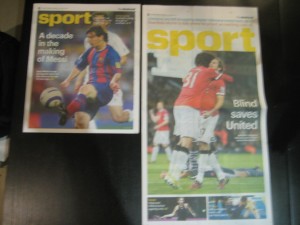Production journalists are creatures of habit. They know what will fit where. How many words with how many pictures. How to assemble four blocks, or five or six, to make a page. Fitting together shapes to complete a puzzle.
And coding it up becomes a synaptic exercise. Just put your fingers on the keys, and they will produce the needed type face and point size. Bang, plakat medium bold.
This comes, however, only after weeks and months of practice.
Thus, I am not sure I have known a production journalist who welcomed a remake in the look of a newspaper. Or a change in the size of the newspaper — which The National went through between last night and tonight.
For the first six-plus years of Abu Dhabi’s English-language newspaper, it was 35 millimeters across (just shy of 14 inches).
With the newspaper in the morning, it is now 31 mm wide (or about 12.5 inches). (Which is, I believe, pretty much standard for U.S. newspapers the past five or six years.)
It makes a difference. Tomorrow’s newspaper is just as long as it was this morning (38 mm or 22.75 inches), but that loss of about 10 percent of the width is noticeable.
The National just got significantly narrower. And looks and feels longer — even when it is not.
(Curiously, the number of words on the typical page has changed hardly at all. The narrower page leads to smaller photos, and with shallower crowns … well, the words are still about 1,600 per page.
For two sections, sports and features, the shape change also a meant a change in format. We were tabloid sections inside broadsheet news and business sections this morning. With the Tuesday newspaper, we, too are broadsheet — albeit not as broad as it was. (Before and after photo, above.)
That means looking at pages quite differently, when laying out a page. When we were tabloid, we were somewhat boxy (when a topic occupied one tab page) or quite horizontal (when a topic covered facing tab pages). We are now quite vertical.
The broadsheet is not as nimble a format as was the tab, which was 16 pages compared to the broadsheet’s eight. Certainly, at least, while we are adjusting from the former to the former.
Time and energy gets lost in the thinking and the planning that would have been instinctive, the day before.
In a couple of months, the new format will become familiar, and the awkwardness for the production-side people will fade.
Change isn’t always bad — though readers daily generally seem to believe it is, and production journalists often would agree.
There was a time when the New York Times never ran photos on its cover, and no doubt the day they started using them neither readers nor staff considered it an improvement.


0 responses so far ↓
There are no comments yet...Kick things off by filling out the form below.
Leave a Comment